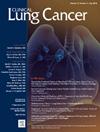丹麦肺癌患者的诊断途径:急诊表现、年龄和吸烟史--一项基于人群的队列研究
IF 3.3
3区 医学
Q2 ONCOLOGY
引用次数: 0
摘要
背景:癌症快速通道旨在加快肺癌的诊断和治疗,是首选的诊断途径。非计划入院(非计划途径)后的诊断与不良预后有关:本研究探讨了与非计划入院后肺癌诊断相关的因素,重点关注老年人群:方法:利用丹麦登记处的人口数据进行回顾性队列研究。研究分析了年龄、合并症、表现状态、吸烟史、社会经济参数和治疗方式等因素与诊断途径和预后的关系:在17835名患者中,16%为老年人(≥80岁)。计划外途径占诊断途径的28%,老年人的比例更高(33%)。表现不佳和疾病晚期与非计划途径有关。已婚患者较少通过非计划途径进行诊断。吸烟对诊断途径没有明显影响。通过非计划途径确诊后,接受治愈性治疗和确诊后12个月死亡的调整后几率分别为0.68(95% CI,0.61-0.76)和1.48(95% CI,1.36-1.61):除了不利的社会经济因素(这些因素在老年患者中更为普遍)外,体弱(表现状态差、合并症多)也与接受非计划性诊断有关。然而,年龄本身却与之无关。非计划入院诊断与治愈性治疗的可能性降低和预后较差有关。为了改善这些患者的预后,有必要扩大筛查范围,将体弱的独居老人包括进来,同时提高初级保健临床医生的警惕性。本文章由计算机程序翻译,如有差异,请以英文原文为准。
Routes to Diagnosis in Danish Lung Cancer Patients: Emergency Presentation, Age and Smoking History—A Population-Based Cohort Study
Background
The fast-track cancer pathway aims to expedite diagnosis of lung cancer and treatment and is the preferred route to diagnosis. Diagnosis following an unplanned admission (unplanned route) has been associated with poor outcomes.
Objective
This study explores factors associated with lung cancer diagnosis following unplanned admissions, focusing on the elderly population.
Methods
A retrospective cohort study using population-based data from Danish registries. Factors such as age, comorbidity, performance status, smoking history, socioeconomic parameters and treatment modality were analyzed in relation to route to diagnosis and prognosis.
Results
Among 17,835 patients, 16% were elderly (≥ 80 years). The unplanned route constituted 28% of diagnostic routes, with higher proportion among the elderly (33%). Poor performance status and advanced disease stage were associated with the unplanned route. Married patients were less likely to undergo an unplanned route to diagnosis. Smoking did not significantly influence diagnostic route. The adjusted odds ratio for curative treatment and dying 12 months after diagnosis, following unplanned route to diagnosis were 0.68 (95% CI, 0.61-0.76) and 1.48 (95% CI, 1.36-1.61), respectively.
Conclusion
Frailty (poor performance status and high burden of comorbidity) in addition to unfavorable socioeconomic factors, which all were more prevalent among elderly patients, were associated with undergoing an unplanned route to diagnosis. However, age itself was not. Diagnosis following unplanned admission correlated with reduced likelihood of curative treatment and poorer prognosis. Expanding screening initiatives to include frail elderly individuals living alone, along with alertness by primary care clinicians, is warranted to improve outcomes for these patients.
求助全文
通过发布文献求助,成功后即可免费获取论文全文。
去求助
来源期刊

Clinical lung cancer
医学-肿瘤学
CiteScore
7.00
自引率
2.80%
发文量
159
审稿时长
24 days
期刊介绍:
Clinical Lung Cancer is a peer-reviewed bimonthly journal that publishes original articles describing various aspects of clinical and translational research of lung cancer. Clinical Lung Cancer is devoted to articles on detection, diagnosis, prevention, and treatment of lung cancer. The main emphasis is on recent scientific developments in all areas related to lung cancer. Specific areas of interest include clinical research and mechanistic approaches; drug sensitivity and resistance; gene and antisense therapy; pathology, markers, and prognostic indicators; chemoprevention strategies; multimodality therapy; and integration of various approaches.
 求助内容:
求助内容: 应助结果提醒方式:
应助结果提醒方式:


